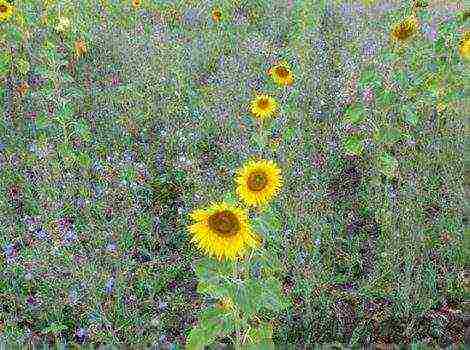Content
- 1 Proper cultivation and care of eggplants outdoors
Proper cultivation and care of eggplants outdoors
In the wild, the vegetable grew many centuries ago, but appeared in Russia only in the 17-18 centuries. The usefulness of eggplant was not immediately appreciated, but alertness soon gave way to great popularity. And not the least role in this was played by the product's ability to lower cholesterol levels, improve heart function and regulate water balance in the body. For successful cultivation in the open field, you must follow the rules of care - you need to love and care for the eggplant, grow seedlings under necessary conditions, add top dressing or cover it in frost.
Where can you grow eggplant outdoors
The conditions for growing eggplant are somewhat different from the cultivation of other vegetable crops. The main differences are as follows:
- yield is provided only on fertile soils with light structure;
- even short frosts are excluded after disembarkation;
- the minimum temperature at which the plant slows down development is +20 degrees;
- the length of daylight hours should be within 12 hours;
- the reaction to a lack of moisture is the dropping of buds and ovaries.
Growing in Siberia
It is unlikely that ordinary varieties that were cultivated exclusively in southern countries would have been possible to grow in the open field in Siberia.
Thanks to the many years of work of breeders, it was possible to breed quite a few hybrids that differ cold resistance and short ripening periods and they can be grown not only in the Kuban.
Popular varieties include: Sailor, Nutcracker, Violet Miracle, Robin Hood.
- Sailor
- Purple miracle
- Robin the Hood
In the Urals
In the presence of strict conditions, obtaining a harvest of blue in the Urals is considered a great success. For planting, varieties with a ripening period are selected no more than 95 days... But even this factor does not guarantee success, because the whole point is in agricultural technology. It should focus on accelerating growth.
Popular varieties are: Clorinda, Helios, Epic.
- Clorinda
- Helios
- Epic
In the Moscow region
With the right selection of varieties and hybrids, you can plant eggplants on your garden plot and in the Moscow region. Many summer residents of the Moscow region have already been convinced of this.
Planting is carried out using the seedling method in the middle or end of Maywhen the threat of night frosts, which may be in spring, has passed. Among the popular varieties: Marathon runner, Kashalot, Balagur, Alekseevsky.
- Marathon runner
- Sperm whale
- Joker
- Alekseevsky
Timing for planting eggplant in open ground
Taking into account the climatic features of our country, eggplant cultivation in open beds is carried out in seedlings. Seeds need to be planted in boxes or containers in late March... By the time the seedlings are transferred to the open ground, 3-5 leaves have already formed, the stem and root system will get stronger.
You can plan to plant eggplant seedlings in open ground in the second half of May... Work can only be carried out if the night temperature is established not lower than 15 degrees.
Experienced gardeners do not advise to rush to planting seedlings, since at low temperatures it will not develop anyway, and in case of frost it will die altogether. But at the same time, it is also dangerous to overexpose seedlings in a greenhouse or other room.
The transplant must be performed before the budding period... If ovaries have already formed on young shoots, then the culture will be more difficult to adapt to new conditions, it will become vulnerable to any diseases.
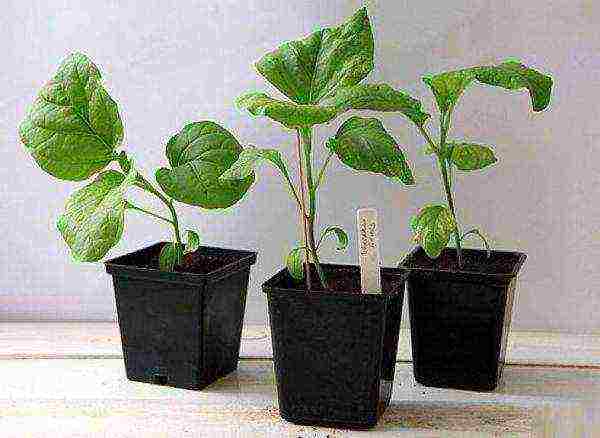
Landing rules
To get a good harvest, you must follow all the rules of agricultural technology. Planting a culture is considered one of the important stages.
The right choice of seeds and seedlings
Seeds go through a preparatory process before planting:
- disinfection (soaking for 25 minutes in a weak solution of potassium permanganate followed by rinsing);
- processing with nutrients to stimulate growth (planting material is immersed in a solution for a day, which is prepared from 1 liter of water at 25-28 degrees and 1 teaspoon of nitrophoska);
- germination (seed moistening and keeping for 1-2 days in a humid environment at a temperature of 30 degrees).
Pre-planting preparation may include hardening the seeds. To do this, they are placed in a refrigerator for 2 days (a compartment for vegetables), then they are kept for a day at a temperature of 18 degrees, after which they are returned to a cold place for 2 days.
After reaching young shoots with a height of 10 cm and the formation of 5-7 leaves, it is planned to transplant into open ground. 10-14 days before this, the seedlings are hardened, that is, they are taken out into the open air every day (without direct sunlight and drafts) for several hours for adaptation.
Preparing the soil before planting in the hole
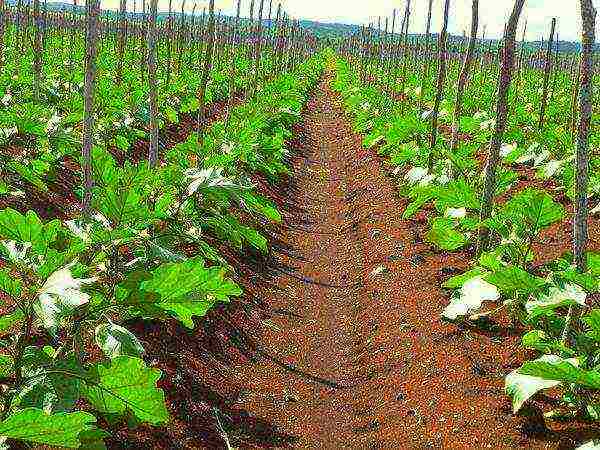
The place for the garden is chosen well lit, ideally, if it is protected from the winds by neighboring shrubs.
Negatively such predecessors as potatoes, peppers, physalis, tomatoes affect the vegetation of eggplants. It is better to choose the area where they were grown: cabbage, cucumber, onion, perennial herbs.
Eggplants respond well to fertile soil with a light structure and a neutral environment. If soil acidification is present, before planting, you need to enter into it dolomite flour or crushed lime.
From fertilizers, both organic (rotted manure 3-4 kg per 1m2) and complex mineral substances (70 grams of superphosphate, 50 grams of potassium sulfate, 25 grams of ammonium nitrate) are used. You should not overdo it with nitrogen nutrition, you can provoke the growth of tops instead of forming ovaries.
The root system of the culture grows in loose soil. If necessary, the soil in the beds is lightened by entering into it peat, humus, river sand... All components or one of them are thoroughly mixed with the dug soil and loosened well with a rake.
Landing
Seedlings are planted in the evening or in cloudy weather. The wells are arranged according to the scheme:
- spacing between plants in a row - 25-30 cm early varieties, 35-40 cm medium and late varieties;
- aisle - 55-70 cm.
Eggplant care during the summer
It is not easy for seedlings to take root in a new place, therefore, proper care must be provided from the first days.
Watering is carried out with settled heated water for about 1-2 times a week (before flowering), you need to focus on the degree of soil moisture. For 1 m2, the consumption rate is 10 l.
With the beginning of flowering and fruiting, irrigation is carried out at the root. If it is not possible to moisten the bed more often than 1 time a week, then the rate of water consumption should be increased.
Eggplants develop ideally at an average temperature of 23-26 degrees, so it is better to avoid freezing or overheating. For protection from the cold, it is recommended use film or agrotextile... In extreme heat, you need to build light shading so that the plants do not get burned or simply do not dry out.
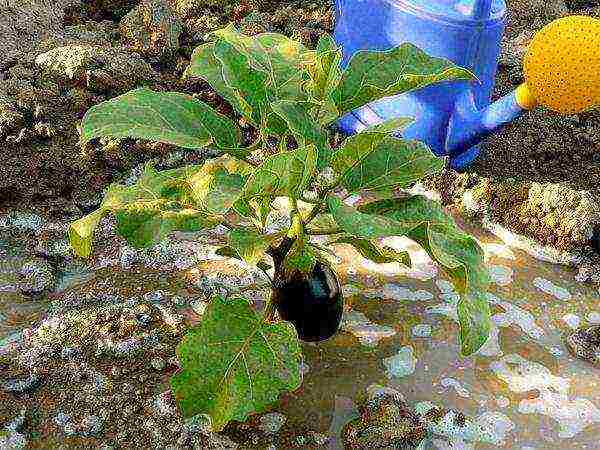
After reaching an escape of 30 cm, do pinch - remove the top of the bush. From the side shoots, 5-6 of the healthiest and strongest should be left, the rest are disposed of. Pickling is not carried out if the summer is very hot and dry.
It is recommended to carry out once a week loosening the soilto prevent clumping. This process is combined with weeding. Weeds create many problems with diseases, attract pests, so they should be dealt with in a timely manner.
How to feed after planting in the garden
During the growing season, they will need to be fed. at least 3 times... The first dose of nutrition is applied 20 days after planting the seedlings. The second time you need to fertilize in 3-4 weeks. The third time to feed the beds during the fruiting period.
Mineral dressing
For normal vegetation, the plant needs the following minerals:
- nitrogen - stimulates the growth of shoots (topical feeding at the initial stage of development);
- phosphorus - helps to strengthen the root system, the formation of ovaries and fruits (used at all stages);
- potassium - strengthens the immune system, stimulates growth, makes the culture resistant to temperature extremes and unfavorable weather conditions;
- boron, manganese, iron - increase the period of fruiting.
Among the popular fertilizers of this type: superphosphate, nitrophoska, ammonium sulfate, potassium nitrate.
Organic fertilizers
Manure, which is better rotted, is used for the first and second feeding. Not less nutritious are:
- bird droppings;
- compost.
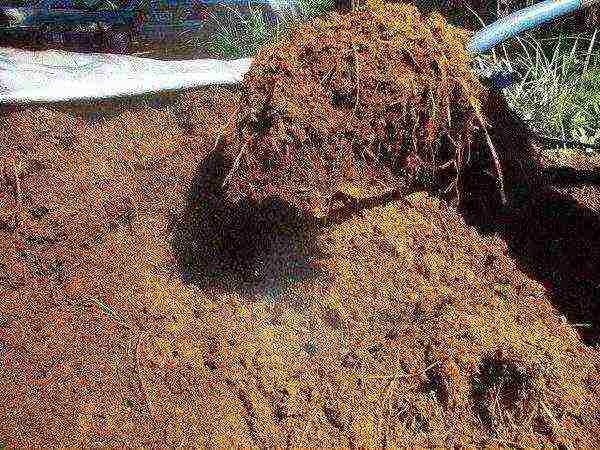
What folk remedies to add for growth
Among the popular recipes, there are many effective, time-tested. For example, mushroom infusionthat stimulates the growth of culture. To prepare a working solution, you will need to pour ½ cup of dried mushrooms with a bucket of warm water and leave to infuse for a day.
Ash liquid (1-2 glasses of wood ash per bucket of water) is also popular among gardeners.
And on a par with it, you can put and yeast feedingpromoting the growth of young shoots. To prepare the fertilizer, a kilogram pack of live yeast is used, which is poured into 5 liters of water at room temperature. A day later, the resulting liquid is diluted with water (1:10) and the plants are watered at the root.
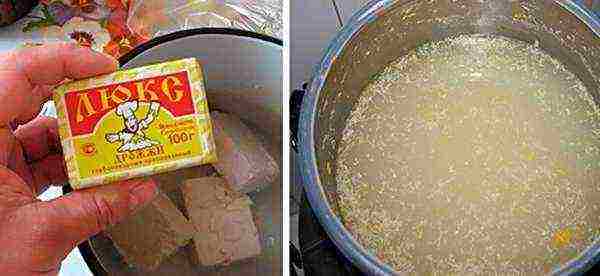
For the preparation of fertilizers, various plants are used, the composition of which is rich in valuable trace elements necessary for the active development of eggplants and so that they are plump.
Among the famous recipes:
- Cup dandelions pour 2 liters of boiling water and cover with a lid, after 3-4 hours add 7 liters of water and use for feeding;
- pharmacy chamomile (1 glass) pour 1 liter of hot water, insist for a day, dilute with 9 liters of water;
- shredded eggshell pour a bucket of water and insist for 1-2 days, after which you can put the solution in the hole or water the plant.
Pests and the fight against them
- Colorado potato beetle - the most dangerous pest of eggplant
- Spider mite
The most dangerous is considered Colorado beetle... When settling in the garden, after a few days, you can notice abundant bald spots, the gluttonous parasite literally gnaws at the shoots.
Treatment with the use of special chemicals or dusting with salt flour, wood ash, spraying with an infusion of wormwood will help to overcome the beetle.
Harmful crops can also be bugs and spider mites... For prevention, the beds are sprayed with infusions of onions or dandelions (with the addition of laundry soap). With the massive colonization of parasites, the following agents are used: Prestige, Zircon, Fitosporin, etc.
Harvesting and storage rules
The first thing that gardeners are guided by when determining the maturity of an eggplant is growing season:
- early varieties - 90-110 days;
- medium varieties - 115-130 days;
- late varieties - 130-140 days.
The ripening time can vary, which is influenced by several factors at the same time: agricultural technology, weather conditions, adherence to planting dates.
There are no obvious signs of ripeness in a vegetable besides the growing season, they are mainly taken into account fruit length... There are standards for each variety, and should be based on them. Color is not considered a featureas it takes on a normal tonality in the early stages of maturation.
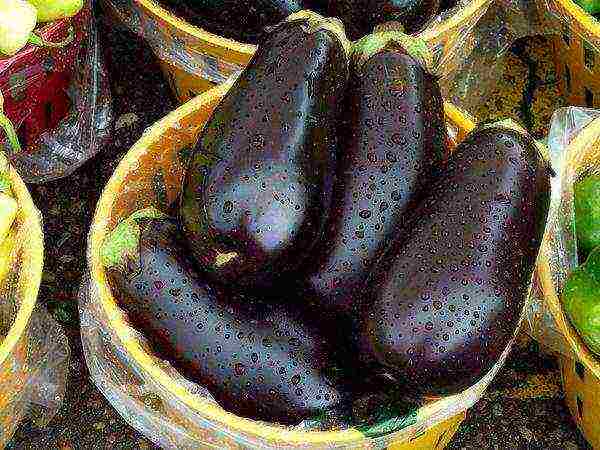
Determination of ripeness can be simple pressing on the eggplant... If the skin is bent, but quickly takes on its original form, the vegetable is ripe.
In order to increase the shelf life of eggplant, you need to select the healthiest specimens without signs of deformation and damage. You can put vegetables in boxes, shifting them with straw or parchment. The fruits are stored in a cool, dark place.
A capricious and sensitive vegetable with unique nutritional and taste qualities can be grown on your site if you follow the rules of agricultural technology. And with proper storage, keep part of the harvest for the New Year's table.

